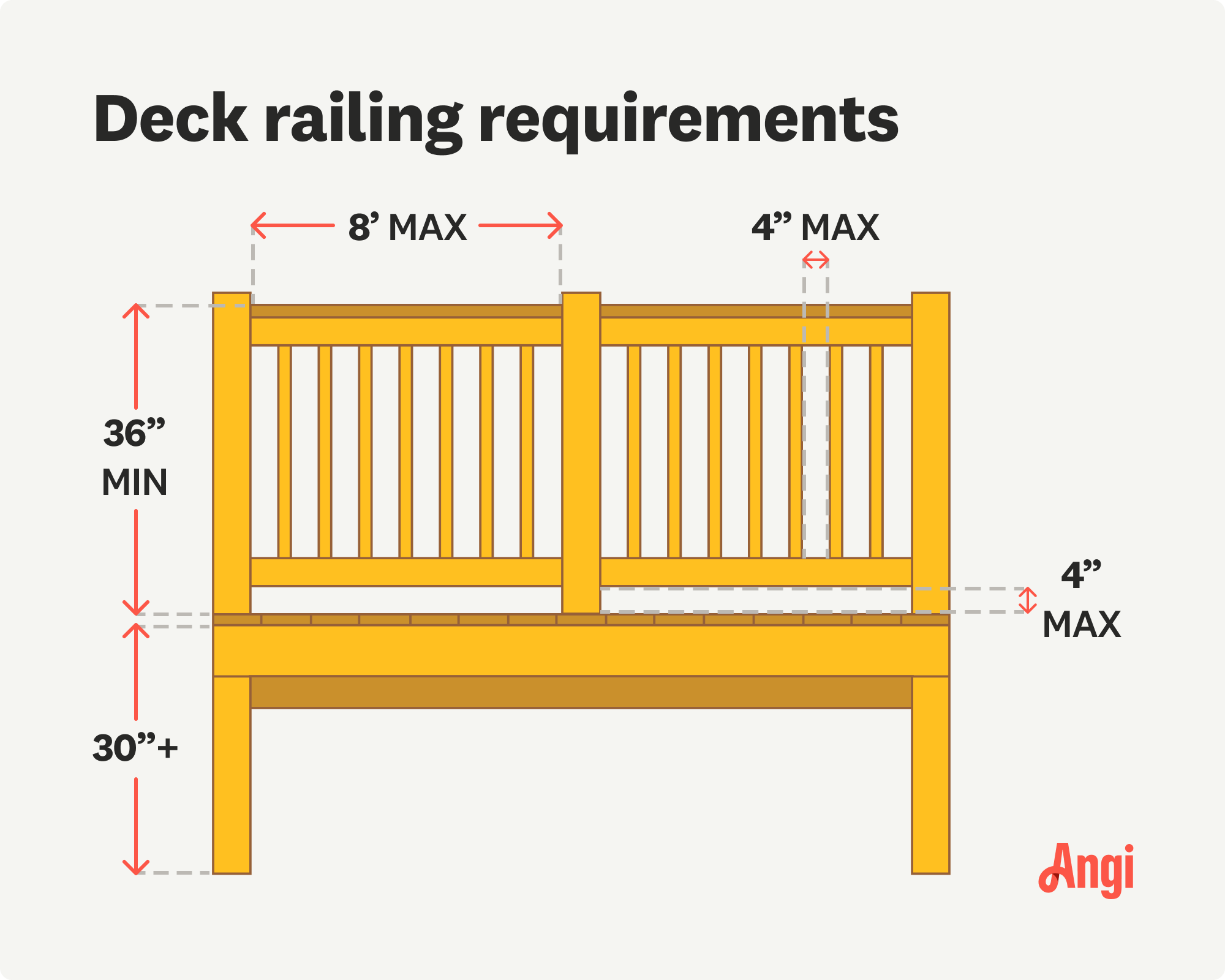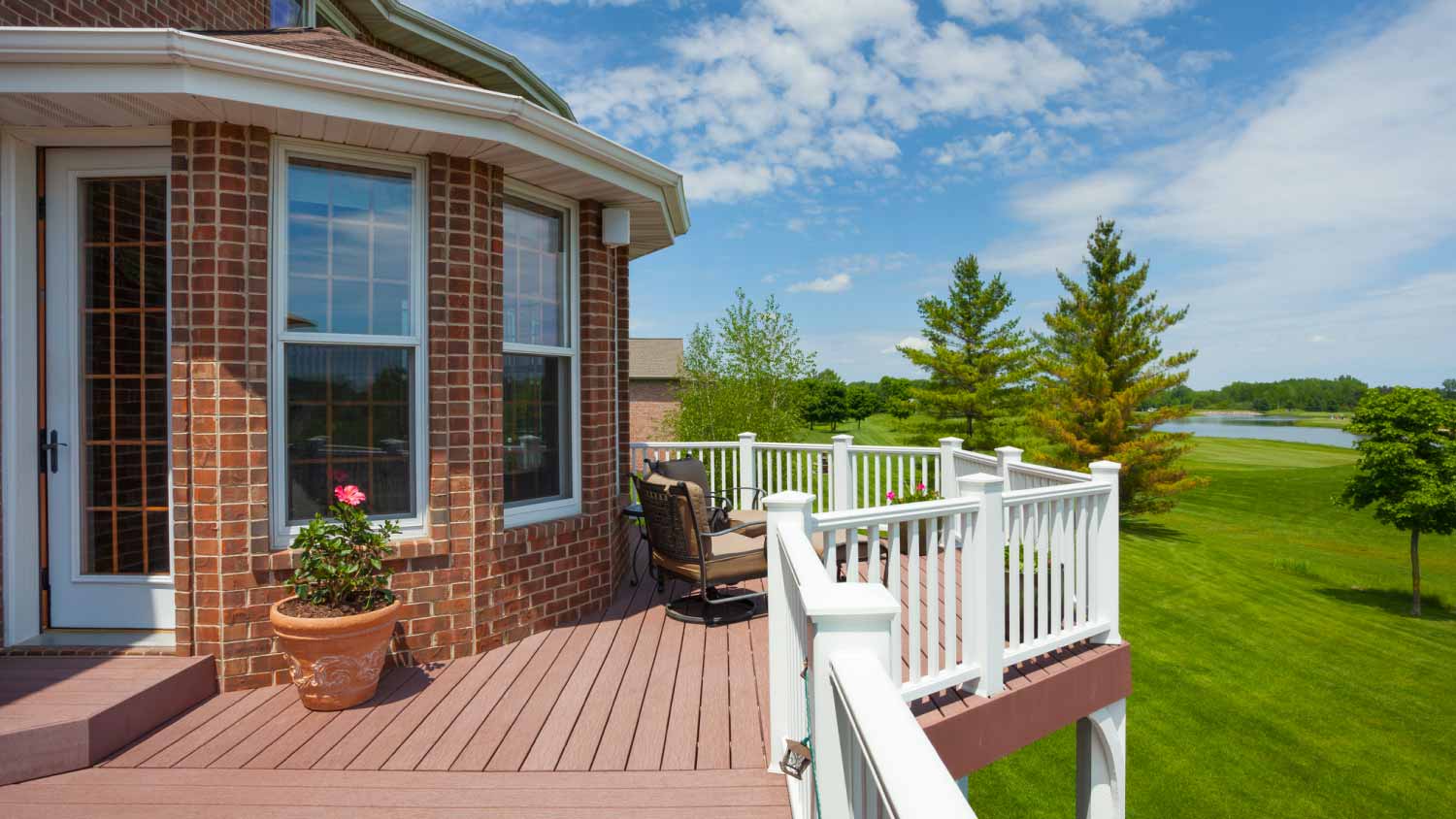
Refinishing your deck is a great way to restore its appearance and fall in love with your outdoor space. Use this guide to learn how much it costs based on factors like size and type.
Deck the halls with the right height railings


The standard deck railing height is 36 inches, though some states require railings to be at least 42 inches tall.
Deck railing height requirements depend on the distance from your deck to the ground.
Even if railings aren’t required by law, it’s wise to install them anyway for safety and aesthetics.
Installing deck railings can be a DIY project, but hiring a professional ensures the railings are installed correctly and in compliance with local codes.
Your deck is an extension of your living space where you can enjoy fresh air and sunshine when the weather allows. However, if your deck lacks proper railings, it can pose a safety concern, which exposes you to liability. This guide explains the rules regarding deck railing heights, how to determine the correct height, and what to do if your deck railings are not up to code.

The standard height for a deck railing is 36 inches, though the exact requirements depend on your area's building codes. The standard railing height is in place to prevent injuries. If the railing were shorter than 36 inches, it would be easier for someone to topple over it and fall off the deck, injuring themselves in the process.
Standard deck railing heights depend on the type of deck. Here’s how railing height differs for every kind of deck.
| Type of Deck | Railing Height |
|---|---|
| Residential (shorter than 30 inches) | No railing required |
| Residential (taller than 30 inches) | 36 inches |
| Residential (certain states) | 42 inches |
| Commercial | 42 inches |
Residential deck railing height guidelines depend on the height of the deck off the ground and the state in which you live. If your deck is less than 30 inches from the ground, you may not need a railing at all. But if it’s more than 30 inches from the ground, you’ll need a railing that’s at least 36 inches tall. Certain states, including California and Washington, require deck railings to be at least 42 inches high.
Commercial deck railing regulations are stricter than those for residential use. Commercial decks experience more foot traffic than residential ones, which increases the risk of injury. Therefore, building codes often require commercial decks to have a railing, regardless of their height above the ground, and the railings must be at least 42 inches tall.

To decide on the right railing height for your deck, you’ll need to take a few basic measurements.
First, measure the height of your deck off the ground. If it’s less than 30 inches tall, you’re not required by law to install a railing. But if it’s more than 30 inches off the ground, a railing is mandatory. If your deck is under 30 inches, you may want to consider installing a railing for aesthetic or safety purposes.
Next, measure 36 inches from the deck to mark the height your railing should be. Note that local regulations may require a taller railing, so check with your local administration before proceeding.
Other railing requirements are as follows:
The spacing between balusters must be four inches or less.
The spacing between the deck and the bottom of the railing must be four inches or less.
Railing posts must be within eight feet of each other to ensure the strength of the railings.
If you’re not sure of the requirements for deck railing height, contact a local deck builder for advice. A pro will be aware of local codes and can recommend the best deck railing height for your outdoor space.
The ideal deck railing height depends on several factors, including the height of your deck, local laws, whether the deck is in a residential or commercial setting, the presence of stairs, and whether the deck needs to be accessible to individuals with disabilities. Here’s how these factors can affect your deck railing height.
A deck that’s close to the ground may not require railings. However, once your deck reaches 30 inches above the ground, the International Residential Code (IRC) mandates deck railings for safety purposes.
Even if your deck’s height doesn’t require railings, it’s wise to consider installing them anyway. Without railings, accidents can occur, and even a fall from 30 inches (just under three feet) can result in injuries.
Your state or local government may have specific rules regarding deck railing height. Generally, most places require deck railings to be at least 36 inches tall, though California and Washington require them to be a minimum of 42 inches high. Check with your local building department to see whether your municipality has specific requirements regarding deck railing height.
Deck railing height guidelines differ when installed in a commercial versus residential setting. While a residential deck might not require a railing if it’s less than 30 inches off the ground, a commercial deck often requires a railing regardless of the height.
The railing height requirements may also be higher. That’s because commercial decks see higher foot traffic, which can increase the risk of falls. Additionally, in a commercial setting, there are liability issues to consider.
If your deck has stairs, it can affect the railing height requirements. The IRC requires deck stair handrails to be between 34 and 38 inches above the nose of the stair tread. In addition, the handrail must be easy to grip for safety reasons.
If you want your deck to be accessible to people with disabilities, you’ll need to follow the Americans with Disabilities Act (ADA) guidelines on deck railings. The ADA requires railings to be between 34 and 38 inches tall with a handrail that can be gripped easily.
If you have the wrong deck railing height, you must address the issue as soon as possible, as it could be a safety hazard—not to mention a building code violation.
Replacing your deck railing can be a DIY project if you have the right tools and are comfortable tackling it. Learning how to build a deck railing is doable, but improper installation can create a safety hazard and expose you to liability if someone falls off your deck due to an unstable railing. Therefore, hiring a pro to replace your deck railing is often the best choice to ensure safe installation that meets local building code requirements.
The cost to install a new deck railing ranges from $10 to $30 per linear foot. The bigger the deck, the more it will cost to replace your railings. Labor costs can also increase if the contractor needs to remove your current railings, install new railings with your current support posts, or replace rotten or damaged posts with new ones.
From average costs to expert advice, get all the answers you need to get your job done.

Refinishing your deck is a great way to restore its appearance and fall in love with your outdoor space. Use this guide to learn how much it costs based on factors like size and type.

Trex decking can offer your home a beautiful, durable outdoor oasis. Learn all about the costs of Trex decking based on space, size, and style.

Trying to calculate your pool deck cost? Our guide walks you through both inground and above-ground pool deck cost factors, such as material, location, and labor rates.

A sinking deck can be a major problem. Learn about the potential answers to the question, “Why is my deck sinking?” as well as their solutions.

Are you wondering what factors might affect a wraparound porch’s cost? Budget for this rustic and charming addition with our cost guide.

Looking to enhance your outdoor living space but can't decide between a veranda versus a porch? Compare the two to find your best outdoor oasis.